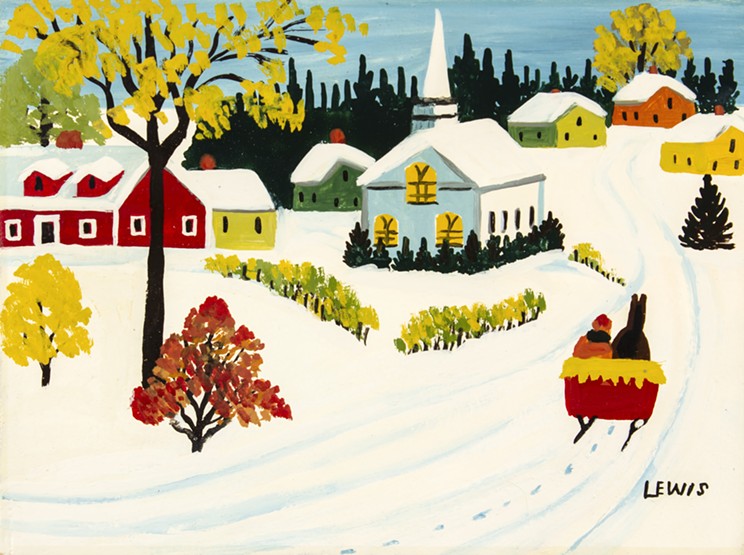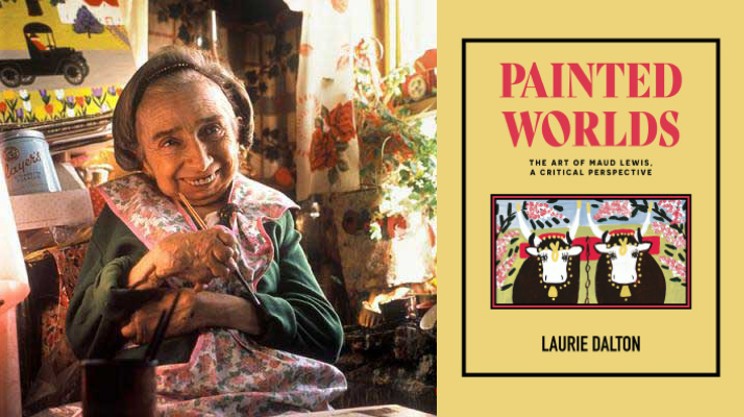The black cats. The bright colours. The halcyon rural settings. It’s impossible to misidentify a Maud Lewis work since, as Interim Director & CEO of the Art Gallery of Nova Scotia Sarah Moore Fillmore, puts it, “you get exactly what you need from the picture…very quickly and very emotionally.” But, despite Lewis’s fame—the record-setting sales of her works, the biopic that saw Sally Hawkins portraying her, the name recognition rarely awarded to a visual artist anymore—it can be surprisingly hard to have the chance to see many of them. (Thank the fact most Lewis originals are owned by private collectors instead of public galleries.)
But, that’s all changing this Saturday, Nov 26, as a new exhibit celebrating the folk artist’s body of work arrives from the McMichael Canadian Art Collection at the Art Gallery of Nova Scotia.
“There's a lot of criticism, as well—and rightfully so—of all of the things that happened to Maud from the outside. Like: infantilizing the work and the story, and telling stories about her using her name Maud and not Lewis,” Moore Fillmore tells me. “You called her Lewis: You’re one of the only people who has ever done that with her.” (Imagine, by contrast, doing this with a male artist: It’s telling that the movie about Abstract Expressionist Jackson Pollock is called Pollock, while Maud Lewis’s movie is called Maudie.)
“People feel like they know her, they can call her by first name, and own the work because it is theirs in a lot of ways. But I think as a museum, it's important that we offer as many entry points without presuming too much about where people are coming from,” she adds, tapping into the deep connection many Nova Scotians have for their province’s most-known artist. But while the narrative that gives art its context is never (and should never) be far from mind, east coaster’s fealty to the folklore of Lewis’s life isn’t the point of this showcase.
Rather than focus on the arthritis some credit for her later work’s simplicity; Instead of the poverty she lived in that’s often risked romanticization in its retelling; In lieu of over-stating her husband’s influence or own art practice, this is a show that returns focus to the rightful centre: Lewis’s artwork.

Moore Fillmore estimates it’s been several years (probably a decade, but she’s reticent to commit to a hard figure) since a show of Lewis’s work of this scale has been mounted in the artist’s home province. The show is a travelling exhibit that’s stopped in Edmonton, Calgary and Hamilton before setting up in Halifax, and to Moore Fillmore it’s a “great partner” to the gallery’s own permanent exhibition of Lewis’s house (which is shown alongside a smattering of Lewis originals in the AGNS, a display that was refreshed with new-to-the-public works for the first time in 14 years this summer).
The self-titled exhibit arrives at what feels like a wider reconsideration of Lewis, thanks to books like Laurie Dalton’s Painted Worlds, released earlier this year, that sees an art historian discussing the merit of Lewis’s creations. Much like Dalton’s tome, the McMichael exhibit Maud Lewis considers things like Lewis’ mastery of colours and her penchant for serialized images (something that has been tied to her disability in the past, but shouldn’t: Artists from Andy Warhol to Claude Monet all repeat and re-explore images in their work.)
“She, in my mind, lives with artists who have stories that people get connected to: Van Gogh and his ear and his illnesses [for example]. People want to see how things are read through a certain lens. But when you walk into the gallery, you're gonna be immediately struck by colour and by style and her ability to draw graphic, decorative elements out of the surroundings, what she was looking at and what people were bringing her. That has started to become part of the way that curators are telling her story: Telling the story of the work,” says Moore Fillmore. “There’s more than meets the eye. It’s more than just her physical story. There's more to it than a cute story of resilience. There's an actual artist in there.”
See Maud Lewis from November 26 to April 23, 2023.


